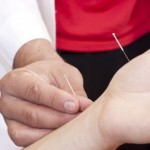 Acupuncture can be incredibly effective for nausea.
Acupuncture can be incredibly effective for nausea.
I learned just how well it could work several years ago at a family gathering. My nephew, who is a crack golfer and the life of the party, was laid low with an upset stomach. It was late afternoon, and we were making plans for dinner, but my nephew told us to count him out — he was miserable and not likely to eat anything or be very much fun.
I happened to have my acupuncture needles with me, and offered to give him a mini-treatment to try to calm down his funky stomach.
He agreed, and I needled a couple of points.
It’s all in the wrist
The main point I used was P6; the 6th point on the Pericardium pathway in Chinese medicine, which is found on the inside of the wrist. The pericardium is the protective tissue around your heart, so P6 is a great point for heart issues such as angina (heart pain) and palpitations.
Also, because of its location on the palm side of your wrist, P6 is a good point if you’re suffering from carpal tunnel pain.
One of the most common uses for P6, however, is for nausea.
That’s because the Pericardium pathway passes through your chest, down through your diaphragm and into your mid and lower abdomen. It its way, the pathway passes through your stomach, and when P6 is needled or stimulated, it can calm a roiling stomach.
I have used P6 many time on patients for effective relief from the flu, morning sickness (it’s safe to use during pregnancy) and for nausea caused by chemotherapy. It also works for motion sickness, and is the theory behind those sea sickness wrist bands.
The bands work because they have a little bead or magnet that rests right on the P6 point.
Acupressure for nausea
You can also use acupressure to stimulate P6 by locating the point and pressing for a minute or two.
Here’s how you can locate the point yourself.
In general, the P6 is found about two inches above your wrist crease on the palm side, right in the middle, in between the tendons. More specifically, in Chinese medicine, the distance between your wrist crease and the elbow crease is twelve units, called cun (pronounced soon). P6 is located two cun above your palm side wrist crease.
The easiest way to find it is to divide the distance between your wrist and elbow in half; six cun each. Then divide the lower half into thirds, and the first third closest to your wrist is the location of P6. Now poke around in between the tendons until you find a spot that is a little tender, and voila! you’ve found the point.
Once you’ve located P6, stimulate where it’s tender by pressing with your thumb or index finger for a minute or two on each side.
The P6 point worked well for my nephew, and after the quick treatment, he started to perk up. By dinnertime he was back to being the life of the party, and everyone thought I could work miracles; a win-win situation for both of us!